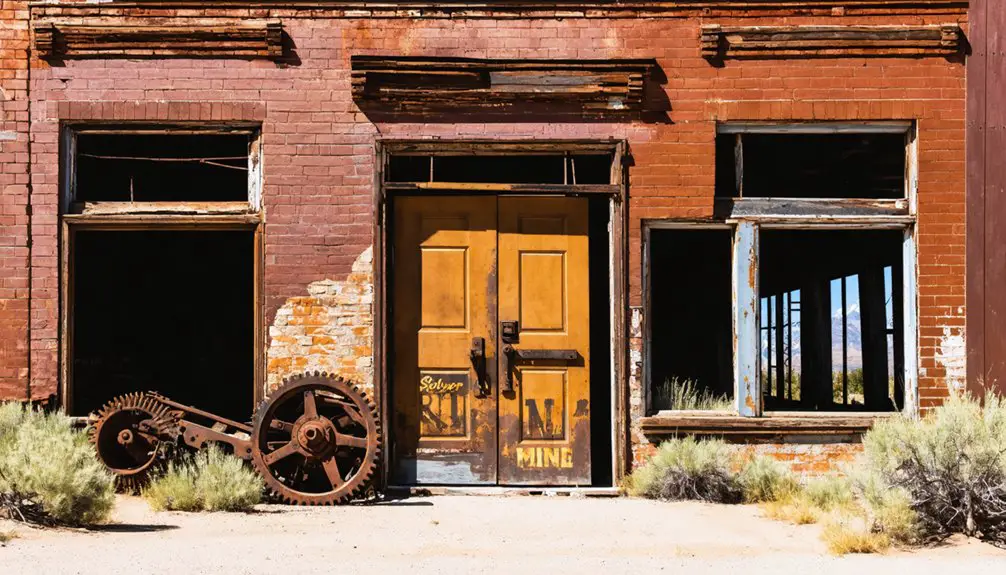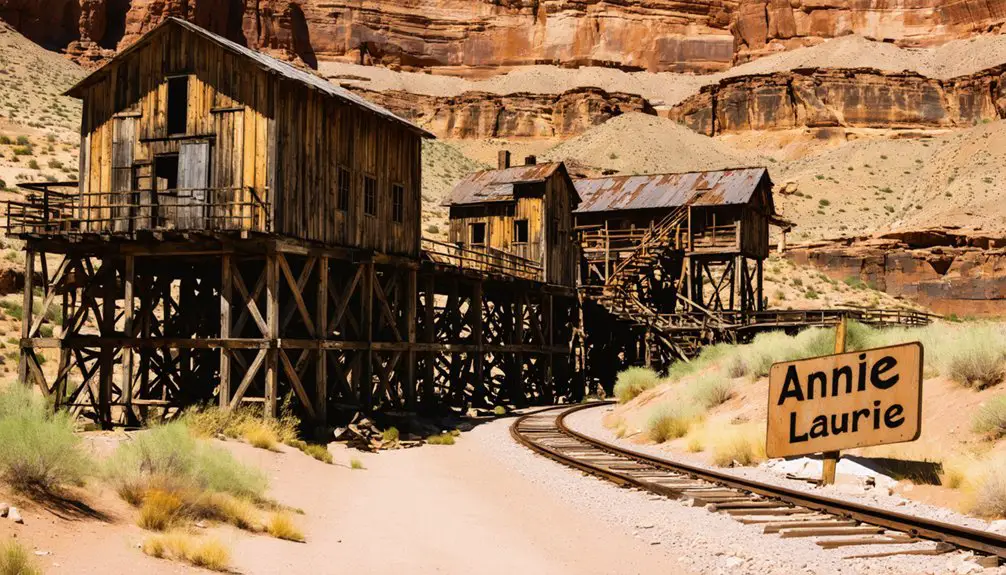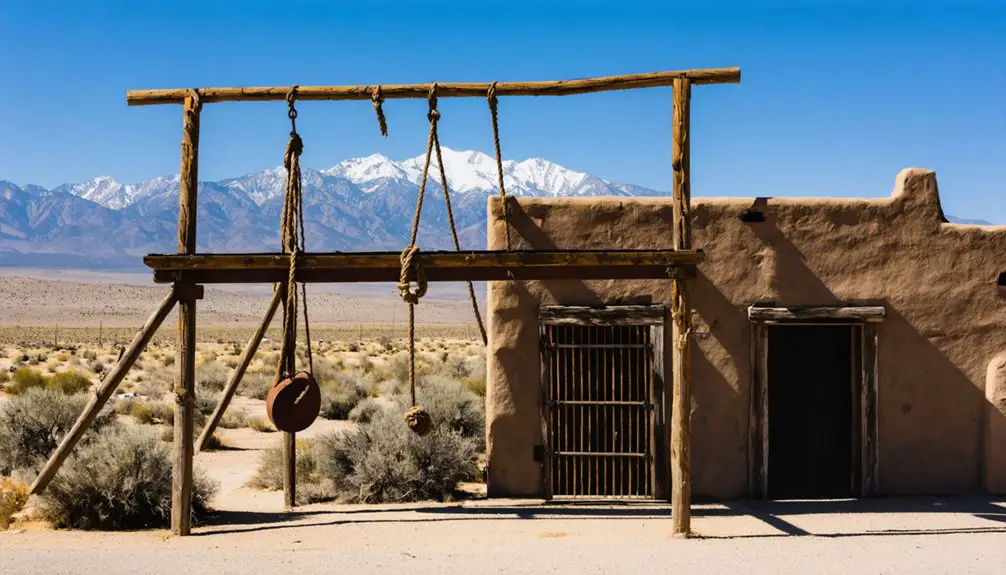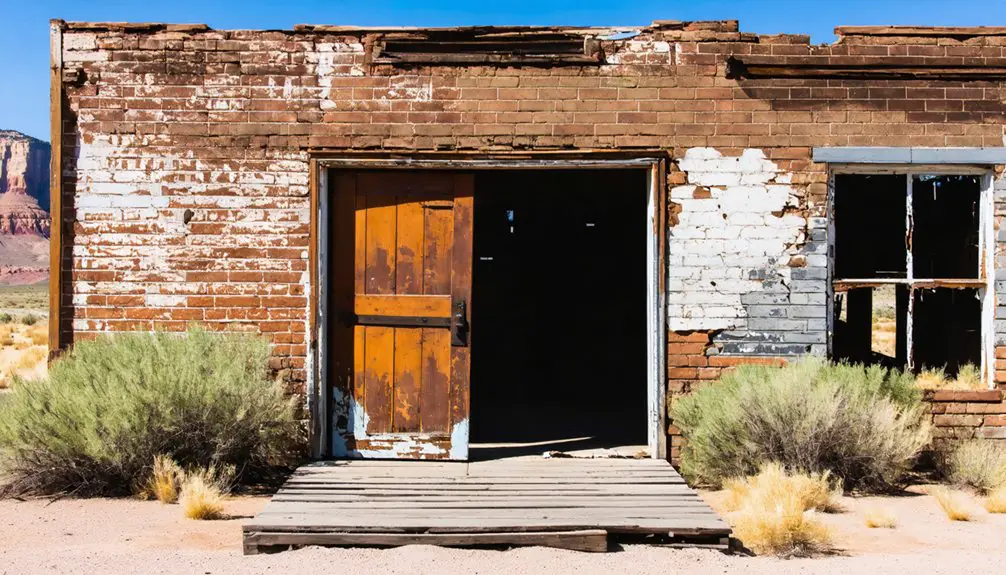You’ll find Kimberly, Utah perched at 8,970 feet in the Tushar Mountains, where it flourished as a gold mining boomtown from 1891 to 1907. The Annie Laurie Mine anchored this remote settlement, supporting 500 residents and producing gold bars worth over $20,000 each. While armed guards once protected millions in precious metals, today you’ll discover only abandoned structures and weathered remnants of a once-thriving mountain community that holds countless untold stories.
Key Takeaways
- Kimberly was a thriving gold mining town at 9,000 feet in Utah’s Tushar Mountains that became abandoned after mining operations ceased in 1907.
- The town peaked with 500 residents during the gold rush, supported by the Annie Laurie Mine which produced millions in gold.
- Divided into Upper and Lower Kimberly, the town featured dance halls, boarding houses, and a schoolhouse serving up to 89 students.
- Harsh mountain winters and the mine’s bankruptcy in the early 1900s led to the town’s eventual abandonment.
- The closure of Kimberly’s post office in 1958 marked its final transition to ghost town status.
The Rise of a Mountain Mining Town
While prospectors had long searched for the legendary “Trapper’s Pride” mine in Utah’s Tushar Mountains, it wasn’t until the 1890s that significant gold and silver discoveries led to Kimberly’s founding.
The Gold Mountain Mining District emerged in April 1889, with the Annie Laurie Mine opening in 1891, revolutionizing mining techniques in the area. Like many Utah mining operations, the town relied on lode mining deposits rather than placer mining. Early community dynamics shaped the town’s development into two distinct sections: Upper Kimberly for residents and Lower Kimberly for businesses.
When investor Peter Kimberly consolidated the mines into the Annie Laurie Consolidated Mining Company, he transformed local operations. Miners earned a steady wage of three dollars per day for their demanding work.
The installation of a cutting-edge cyanide mill in 1902 ramped up production to 250 tons daily, yielding gold bars worth $20,000 each that required armed escorts to railway connections.
Life at 8,970 Feet: Geographic Setting
Perched at nearly 9,000 feet in Utah’s Tushar Mountains, Kimberly’s remote location presented residents with profound isolation and the daily challenges of high-altitude living.
You’d find the community divided between Upper and Lower Kimberly, where steep canyon walls and harsh mountain weather shaped everything from housing placement to business operations.
The town’s position atop rich gold and silver deposits made the difficult mountain setting worthwhile, though you’d have to contend with seasonal extremes that dictated school schedules, mining operations, and daily life. Similar to how USS Kimberley ships navigated challenging conditions at sea, the town’s residents had to adapt to the harsh mountain environment. Nestled within Mill Creek Canyon, the settlement provided access to extensive trail networks that connected the isolated community to neighboring areas.
Mountain Challenges and Isolation
Located at a breathtaking 8,970 feet above sea level, Kimberly, Utah faced extraordinary challenges due to its position on Gold Mountain in the Tushar Mountains of northwestern Piute County.
You’d have noticed the elevation challenges immediately: thinner air strained your lungs, while the rugged terrain confined settlement to narrow spaces like Mill Canyon. The steep mountainous landscape created natural barriers, intensifying the town’s geographic isolation.
You couldn’t rely on railroads here. Instead, you’d have to navigate primitive roads and trails, making every supply run a significant undertaking.
The demanding environment shaped daily life, from the shortened school year to limited medical services.
Even mining operations had to adapt, with workers splitting their time between Upper and Lower Kimberly, while specialized facilities processed ore on-site to avoid difficult transport down the mountain.
Seasonal Weather Impact
The extreme elevation of 8,970 feet didn’t just isolate Kimberly – it created a harsh climate that dominated life in the mountain settlement. You’d experience severe winters with temperatures plunging below freezing, while summers remained brief and mild. The high altitude’s thin air would’ve challenged your endurance in daily activities.
Weather patterns shaped everything about life in Kimberly. Late fall through spring, you’d face heavy snowfall that blocked roads and trails, limiting seasonal accessibility to warmer months. Modern data from the SNOTEL monitoring site at 9,110 feet continues to track these challenging conditions.
The Tushar Mountains’ orographic effect triggered precipitation peaks, especially during winter storms and late summer monsoons. When spring arrived, snowmelt flooded the area, recharging groundwater but creating hazardous conditions.
These intense seasonal cycles ultimately made year-round habitation impractical, contributing to the town’s abandonment.
Natural Resource Access Point
Nestled within Mill Canyon along Gold Mountain’s steep slopes, Kimberly emerged as a critical mining hub in Utah’s Tushar Mountains at 8,970 feet elevation.
You’ll find the town naturally divided between Upper Kimberly’s residential area and Lower Kimberly’s business district, shaped by the canyon’s rugged terrain at 38°29′N 112°23′W.
The Gold Mountain Mining District’s establishment in 1889 revolutionized local mining techniques, particularly at the Annie Laurie Mine.
The addition of a cyanidation plant enhanced resource management capabilities, though you’d face significant challenges operating at this altitude.
Water resources required careful management for ore processing, while the mountainous typography demanded innovative approaches to maintaining mines and buildings.
The high elevation affected everything from construction to transportation, requiring adaptations to overcome the harsh environmental constraints.
Gold Mountain’s Glory Days
You’d have found Kimberly buzzing with activity during its peak years, as the Annie Laurie Consolidated Mining Company employed around 300 miners who extracted gold worth millions in today’s value.
The wealth pouring from Gold Mountain’s veins transformed this high-altitude settlement into a proper mining town, complete with dance halls and a thriving business district split between Upper and Lower Kimberly.
The district was accessed by several mining adits carved into the rugged mountainside, allowing miners to efficiently extract the precious metals.
After founder Peter Kimberly made the fateful decision to reject a $5 million offer in 1902, the town’s fortunes began to decline.
At the height of production, gold bars worth over $20,000 each were carefully guarded during transport from the mountain’s rich ore processing facilities, which handled 250 tons daily.
Mining Wealth Attracts Many
After prospectors discovered rich veins of gold and silver in 1888, the Gold Mountain Mining District quickly transformed into one of Utah’s most prosperous mining regions.
You’d have found mining opportunities drawing hundreds of workers to the area, with about 300 miners employed at the Kimberly Mine alone during its peak.
This wealth migration sparked the rapid growth of Kimberly, which split into two distinct areas – Lower Kimberly for business and Upper Kimberly for housing.
The district’s success was evident in its gold production, with massive gold bars worth over $20,000 each being transported under armed guard to Sevier’s railroad.
The Annie Laurie Consolidated Mining Company’s 250-ton daily capacity cyanide mill, built in 1902, further cemented the region’s reputation as the “Queen of Utah gold camps.”
Today, visitors can access the historic site via a well-graded road, though only crumbling buildings and waste deposits remain of its former glory.
Dance Halls Light Up
While gold and silver drew workers to Kimberly, the town’s dance hall became the crown jewel of social life during the mining boom.
Built by the mining company, it boasted one of Utah’s finest dance floors, complete with a pavilion and clubhouse featuring pool tables and reading rooms.
You’d find the dance hall culture thriving as a crucial escape from the harsh realities of mining life. Community gatherings brought miners and their families together, fostering social bonds in an otherwise rough environment.
The hall operated during Kimberly’s peak years through the early 1900s, until the mine’s bankruptcy in 1910 led to its decline.
From Boomtown to Bankruptcy

Despite its promising start in the late 1800s, Kimberly’s journey from boomtown to bankruptcy unfolded rapidly during the early 1900s.
This once-thriving mining town’s descent into ghost town status serves as a stark reminder of the volatile nature of America’s mining history.
- You’d have witnessed the town’s dramatic fall when mining operations ceased in 1907, crushing the local economy that had supported 500 residents.
- The Great Depression of the 1930s delivered another devastating blow, effectively ending any hopes of revival.
- The Annie Laurie mine, once valued at $5 million, was sold at auction for a mere $31,000.
- By 1958, the closure of the post office marked the final chapter of community life, despite Kennecott Copper Corporation’s acquisition of the property.
The town’s decline was accelerated after extensive tailings development completely erased the original townsite from the landscape.
Daily Life in a Mining Community
Life in Kimberly centered around the harsh realities of mountain mining, where you’d find a stark division between Upper Kimberly‘s residential area and Lower Kimberly‘s bustling business district.
You’d earn about three dollars a day working the mines, extracting gold, silver, lead, and copper alongside 300 other men braving the dangerous conditions.
Community dynamics reflected the wild frontier spirit, with violence and drunkenness common enough to warrant a sturdy two-cell jail.
The rough-and-tumble lifestyle of frontier mining towns bred chaos and lawlessness, keeping the local jail cells consistently occupied.
You’d live in simple log homes or shacks near the mines, making the treacherous winter commute more manageable. A snow-covered landscape surrounded residents throughout the long winter months.
The town’s mining routines extended beyond underground work to include hauling freight and cutting lumber.
After your shift, you might find entertainment in the notorious brothels or gather with fellow miners at local boarding houses, all while surrounded by the rugged mountain landscape.
The Annie Laurie Mine Legacy

The Annie Laurie Mine shaped Kimberly’s destiny from its 1891 opening, when Newton Hill named the operation after his daughters. You’ll find this mine’s legacy embedded in Utah’s mining history, where mining innovations like the cyanidation process revolutionized gold extraction and boosted production to 250 tons daily.
- The consolidation under Peter Kimberly’s leadership transformed labor relations, employing 300 miners and supporting a thriving community of 500 residents.
- The mine’s peak years (1901-1908) generated $500,000 in dividends, with gold bars worth $20,000 each shipped under guard.
- The operation’s advanced mill facilities divided Kimberly into distinct business and residential districts.
- Though the boom ended by 1907, the mine’s impact on Utah’s gold-producing reputation remains significant, offering insights into Western mining development.
Education and Healthcare on Gold Mountain
While miners extracted gold from the Tushar Mountains, their children attended classes at Gold Mountain School District‘s log schoolhouse, established in 1900 to serve Kimberly’s growing population.
With enrollment peaking at 89 students in 1903, the school faced unique education challenges due to its remote location. You’d find students attending from April through November to avoid treacherous winter conditions that made travel impossible.
Healthcare limitations were stark in this isolated mining town. Without a dedicated hospital or clinic, you’d rely on traveling doctors or knowledgeable miners for medical care.
Mining injuries, respiratory issues from dust, and chemical exposure from the cyanidation plant posed serious health risks. For major medical emergencies, you’d need to brave the journey to larger towns, weather permitting.
Law and Order in the High Country

Perched at 9,000 feet in Utah’s Tushar Mountains, Kimberly’s wild frontier atmosphere demanded strong law enforcement measures, including a formidable two-cell brick jail that stood as the region’s most secure detention facility.
- Violence, murder, and drunken brawls plagued the mining town, where social order often crumbled amid the chaos of gold rush fever.
- The jail’s iron cells, though compact, effectively contained the most dangerous offenders in a town known for its brothels and lawlessness.
- Armed guards protected valuable gold shipments while battling the challenges of harsh winters and remote terrain.
- Law enforcement faced constant struggles maintaining order, especially during winter months when the isolated mountain town was cut off from outside authority.
You’ll find that Kimberly’s approach to justice reflected the raw reality of frontier life, where maintaining social order meant building strong walls and accepting imperfect solutions.
What Remains: A Ghost Town’s Legacy
Standing sentinel at 9,000 feet in Utah’s rugged Tushar Mountains, Kimberly’s haunting remains tell a story of boom-and-bust mining aspirations.
Today, you’ll find ghostly remnants scattered across the mountainside: building foundations that map the town’s original layout, skeletal structures of the once-mighty Annie Laurie Mine, and the weathered ruins of the two-cell jail.
Among these historical artifacts, you can trace the distinct divisions between Upper and Lower Kimberly, where miners once lived and conducted business.
While most original structures were dismantled by mid-century, the site’s cyanide mill ruins and miners’ shacks offer glimpses into the town’s golden era.
Though abandoned since 1938, Kimberly’s legacy lives on through these physical remains and its connection to notable figures like Ivy Baker Priest, former U.S. Treasurer.
Frequently Asked Questions
Are There Any Surviving Photographs of Kimberly During Its Peak Years?
You’ll find surviving photographs in historical documentation and photographic archives, showing family portraits, mining operations, and daily life from Kimberly’s peak years before its 1938 abandonment.
What Happened to the Families Who Lived There After the Town’s Abandonment?
Scattering to nearby towns, breaking ties, seeking new starts – you’ll find these families faced massive displacement by 1910. Historical records suggest they relocated where mining jobs remained or integrated into other Utah communities.
Can Visitors Legally Explore the Ghost Town Site Today?
You can legally explore the ghost town site on public Forest Service land, but you’ll need to follow visitor guidelines: no artifact removal, respect structures, and prepare for remote conditions.
Were Any Major Gold Discoveries Made by Individual Prospectors in the Area?
Like pioneers striking gold in their dreams, you’ll find Newton Hill’s Annie Laurie Mine and Willard Snyder’s Bald Mountain discoveries were major strikes during Utah’s gold rush, marking significant prospecting history successes.
Did Any Other Industries Besides Mining Exist in Kimberly?
You won’t find evidence of substantial agricultural practices or timber industry here – the town’s economy centered entirely on mining and mining-related services like transport, company stores, and entertainment venues.
References
- https://en.wikipedia.org/wiki/Kimberly
- https://www.youtube.com/watch?v=6xRL35Zq7qM
- https://thepaiutetrail.com/kimberly/
- https://digging-history.com/2014/05/21/ghost-town-wednesday-kimberly-utah/
- https://www.youtube.com/watch?v=P8U7Qq0gRuQ
- https://historytogo.utah.gov/gold-rushes/
- https://www.mindat.org/loc-37447.html
- https://onlineutah.us/kimberlyhistory.shtml
- https://www.govinfo.gov/content/pkg/FR-1967-06-23/pdf/FR-1967-06-23.pdf
- https://extension.usu.edu/sanpete/files/Utah_Altitude_Chart_by_City.pdf



